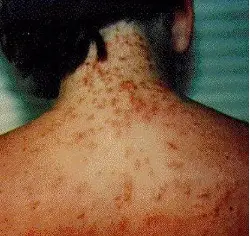Sea Lice Attacking Florida’s Beaches-Truth! & Misleading!

Summary of eRumor:
Warnings that sea lice have invaded beaches in Florida have sparked panic on social media.
The Truth:
Warnings about sea lice on Florida beaches are true — but they’re also misleading.
Posts began circulating on social media in early June that warned Florida beachgoers of sea lice “invasions” that have left swimmers with painful red welts all over their bodies, like the one pictured here:
The photo is real, and it was circulated by Florida public health officials in a warning about sea lice or “seabather’s eruption,” at beaches. Sea lice are actually the larvae of jellyfish, which are nearly invisible in ocean waters but leave simmers with painful red welts on their skin, according to public health officials:
For the past 11 years, during the months of March through August, residents and tourists along 250 miles of Florida’s southern Atlantic coastline have complained of an annoying pruritic rash, primarily within areas covered by bathing suits. Although this problem has existed since the early 1900s at least, it has not been formally recognized and understood until recently. The first study (a retrospective case review of ED cases seen during 1992) and a sample population survey were conducted at Boca Raton Community Hospital. The outbreaks appear to have intensified in the last 4 years, as reflected in the number of cases reported as well as the severity of response in individual cases. Because most affected people treat themselves, it is difficult to determine the total annual number of cases. However, a conservative estimate of 10,000 cases in 1992 can be made.
So, the phenomenon isn’t new, and most residents of Florida and other warm weather states are well aware of sea lice. In 2016, sea lice outbreaks appeared to be cropping up further west in the Gulf of Mexico than in year’s past, and headed toward Alabama beaches, an NBC affiliate reports.
We’re calling warnings about sea lice true, but misleading. Sea lice isn’t necessarily new, and there doesn’t seem to be a greater risk of swimmers being affected by it in 2016 than in year’s past.
